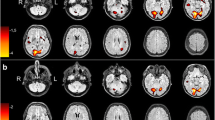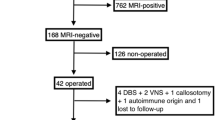Abstract
Objective
A multicenter prospective study was performed to assess the additional value of a subtraction ictal SPECT coregistered to MRI (SISCOM) technique to traditional side-by-side comparison of ictal- and interictal SPECT images in epilepsy surgery.
Methods
One hundred and twenty-three patients with temporal and extratemporal lobe epilepsy who had undergone epilepsy surgery after evaluation of scalp ictal and interictal electroencephalogram (EEG), MRI, and ictal and interictal SPECT scans were followed up in terms of postsurgical outcome for a period of at least 1 year. Three reviewers localized the epileptogenic focus using ictal and interictal SPECT images first by side-by-side comparison and subsequently by SISCOM. Concordance of the localization of the epileptogenic focus by SPECT diagnosis with the surgical site and inter-observer agreement between reviewers was compared between side-by-side comparison and SISCOM. Logistic regression analysis was performed in predicting the surgical outcome with the dependent variable being the achievement of a good postsurgical outcome and the independent variables using the SISCOM, side-by-side comparison of ictal and interictal SPECT images, MRI, and scalp ictal EEG.
Results
The SISCOM presented better concordance in extratemporal lobe epilepsy and less concordance in temporal lobe epilepsy than side-by-side comparison. Inter-observer concordance was higher in SISCOM than in side-by-side comparison. Much higher concordance of the epileptogenic focus by SPECT diagnosis with the surgical site was obtained in patients with good surgical outcome than in those with poor surgical outcome. These differences in concordance between good and poor surgical outcomes were greater in SISCOM than in side-by-side comparison. Logistic regression analysis showed the highest odds ratio of 12.391 (95% confidence interval; 3.319, 46.254) by SISCOM evaluation for concordance of the epileptogenic focus with the surgical site in predicting good surgical outcome.
Conclusions
A SISCOM technique of ictal and interictal SPECT images provides higher predictive value of good surgical outcome and more reliability on the diagnosis of the epileptogenic focus than side-by-side comparison in medically intractable partial epilepsy.



Similar content being viewed by others
References
Schäuble B, Cascino GD. Advances in neuroimaging: management of partial epileptic syndromes. Neurosurg Rev. 2003;26:233–46.
O’Brien TJ, So EL, Mullan BP, Hauser MF, Brinkmann BH, Bohnen NI, et al. Subtraction ictal SPECT co-registered to MRI improves clinical usefulness of SPECT in localizing the surgical seizure focus. Neurology. 1998;50:445–54.
O’Brien TJ, So EL, Mullan BP, Hauser MF, Brinkmann BH, Jack CR Jr, et al. Subtraction SPECT co-registered to MRI improves postictal SPECT localization of seizure foci. Neurology. 1999;52:137–46.
Véra P, Kaminska A, Cieuta C, Hollo A, Stiévenart JL, Gardin I, et al. Use of subtraction ictal SPECT co-registered to MRI for optimizing the localization of seizure foci in children. J Nucl Med. 1999;40:786–92.
Cascino GD. Advances in neuroimaging: surgical localization. Epilepsia. 2001;42:3–12.
Kaiboriboon K, Lowe VJ, Chantarujikapong SI, Hogan RE. The usefulness of subtraction ictal SPECT coregistered to MRI in single- and dual-headed SPECT cameras in partial epilepsy. Epilepsia. 2002;43:408–14.
Bouilleret V, Valenti MP, Hirsch E, Semah F, Namer IJ. Correlation between PET and SISCOM in temporal lobe epilepsy. J Nucl Med. 2002;43:991–8.
O’Brien TJ, So EL, Cascino GD, Hauser MF, Marsh WR, Meyer FB, et al. Subtraction SPECT coregistered to MRI in focal malformations of cortical development: localization of the epileptogenic zone in epilepsy surgery candidates. Epilepsia. 2004;45:367–76.
Wichert-Ana L, de Azevedo-Marques PM, Oliveira LF, Fernandes RM, Velasco TR, Santos AC, et al. Ictal technetium-99 m ethyl cysteinate dimer single-photon emission tomographic findings in epileptic patients with polymicrogyria syndromes: a subtraction of ictal-interictal SPECT coregistered to MRI study. Eur J Nucl Med Mol Imaging. 2008;35:1159–70.
O’Brien TJ, So EL, Mullan BP, Cascino GD, Hauser MF, Brinkmann BH, et al. Subtraction peri-ictal SPECT is predictive of extratemporal epilepsy surgery outcome. Neurology. 2000;55:1668–77.
Kaminska A, Chiron C, Ville D, Dellatolas G, Hollo A, Cieuta C, et al. Ictal SPECT in children with epilepsy: comparison with intracranial EEG and relation to postsurgical outcome. Brain. 2003;126:248–60.
Ahnlide JA, Rosén I, Lindén-Mickelsson Tech P, Källén K. Does SISCOM contribute to favorable seizure outcome after epilepsy surgery? Epilepsia. 2007;48:579–88.
Engel J Jr, Van Ness PC, Rasmussen TB, Ojemann LM. Outcome with respect to epileptic seizures. In: Engel Jr J, editor. Surgical treatment of the epilepsies. New York: Rave Press; 1993. p. 609–21.
Woods RP, Cherry SR, Mazziotta JC. Rapid automated algorithm for aligning and reslicing PET images. J Comput Assist Tomogr. 1992;16:620–33.
Matsuda H, Ohnishi T, Asada T, Li ZJ, Kanetaka H, Imabayashi E, et al. Correction for partial-volume effects on brain perfusion SPECT in healthy men. J Nucl Med. 2003;44:1243–52.
Andreasen AR, Lassen NA. Single-photon emission computed tomography in temporal lobe epilepsy. In: Dam M, Gran L, editors. Comprehensive epileptology. New York: Raven Press; 1991. p. 375–84.
Duncan JS. Imaging and epilepsy. Brain. 1997;120:33–77.
Grünwald F, Menzel C, Pavics L, Bauer J, Hufnagel A, Reichmann K, et al. Ictal and interictal brain SPECT imaging in epilepsy using technetium-99 m-ECD. J Nucl Med. 1994;35:1896–901.
Newton MR, Berkovic SF, Austin MC, Rowe CC, McKay WJ, Bladin PF. SPECT in the localisation of extratemporal and temporal seizure foci. J Neurol Neurosurg Psychiatry. 1995;59:26–30.
Hong KS, Lee SK, Kim JY, Lee DS, Chung CK. Pre-surgical evaluation and surgical outcome of 41 patients with non-lesional neocortical epilepsy. Seizure. 2002;11:184–92.
Spencer SS, Theodore WH, Berkovic SF. Clinical applications: MRI, SPECT, and PET. Magn Reson Imaging. 1995;13:1119–24.
Quesney LF. Extratemporal epilepsy: clinical presentation, pre-operative EEG localization and surgical outcome. Acta Neurol Scand. 1992;140(Suppl):81–94.
Fujimoto A, Masuda H, Homma J, Sasagawa M, Kameyama S. False lateralization of mesial temporal lobe epilepsy by noninvasive neurophysiological examinations—case report. Neurol Med Chir (Tokyo). 2006;46:518–21.
Acknowledgments
This study was supported by the Japanese Foundation of Neurosciences and Mental Health. We are thankful to Dr. Noriko Tanaka, Department of Clinical Bioinformatics, Graduate School of Medicine, University of Tokyo, for valuable suggestion on statistical analysis of the present study and Mr. John Gelblum for proofreading of this manuscript.
Author information
Authors and Affiliations
Corresponding author
Rights and permissions
About this article
Cite this article
Matsuda, H., Matsuda, K., Nakamura, F. et al. Contribution of subtraction ictal SPECT coregistered to MRI to epilepsy surgery: a multicenter study. Ann Nucl Med 23, 283–291 (2009). https://doi.org/10.1007/s12149-009-0236-6
Received:
Accepted:
Published:
Issue Date:
DOI: https://doi.org/10.1007/s12149-009-0236-6




